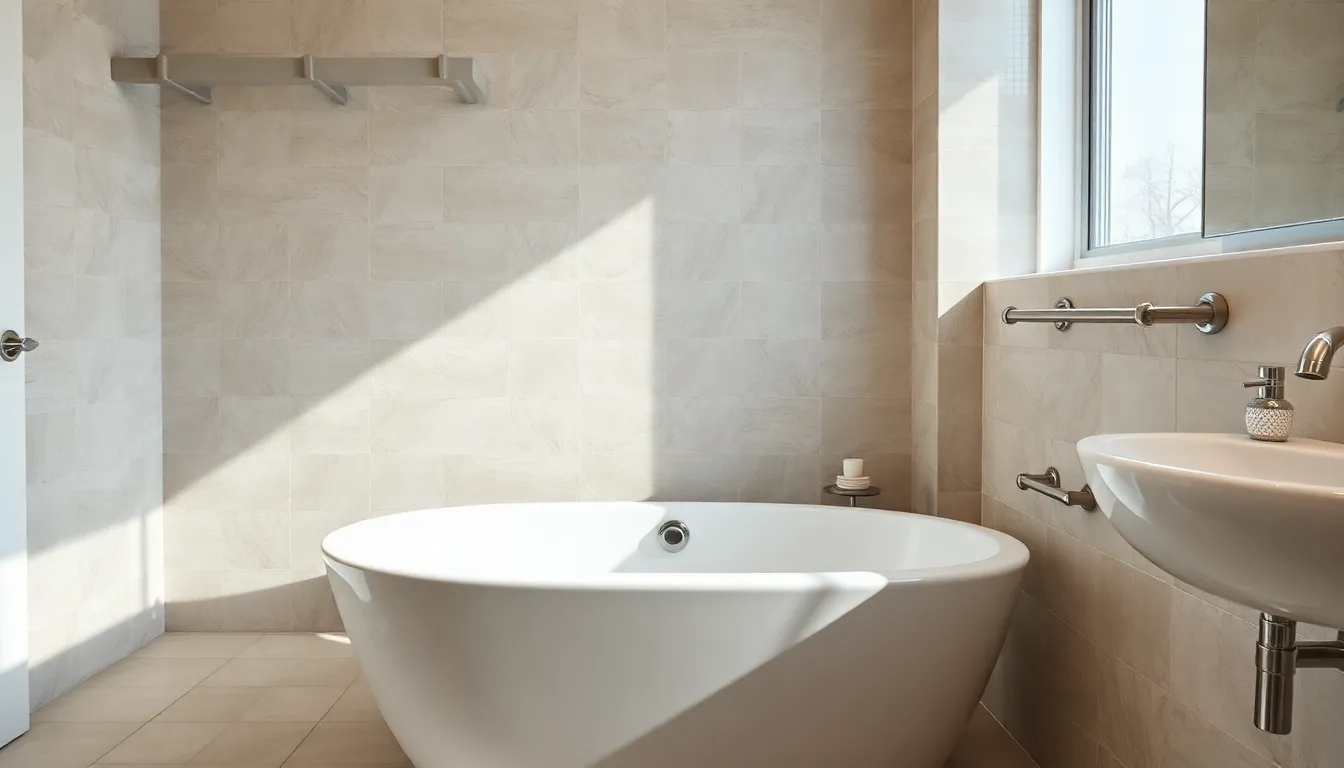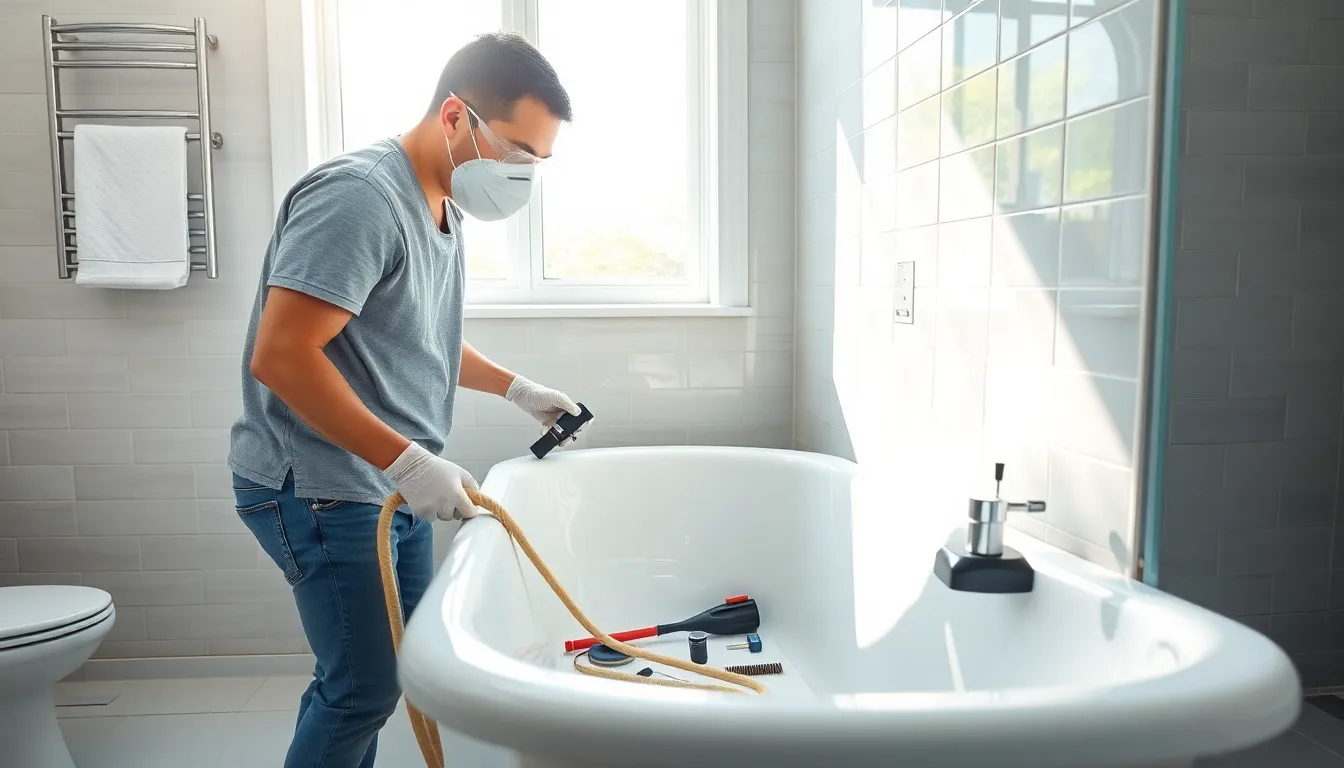Bathtub refinishing offers a cost-effective solution for homeowners looking to revitalize their tired and worn-out tubs. Instead of the hassle of a full replacement, this process allows for a stunning transformation that can breathe new life into any bathroom. With the right techniques and materials, a dull, chipped surface can become a glossy, like-new centerpiece.
Many people underestimate the impact of a well-maintained bathtub on their home’s overall appeal. Refinishing not only enhances aesthetics but also extends the lifespan of the tub, making it a smart investment. Whether it’s a classic porcelain tub or a modern acrylic one, refinishing can address a variety of issues, from stains to scratches, ensuring a durable finish that stands the test of time.
Table of Contents
ToggleWhat Is Bathtub Refinishing?
Bathtub refinishing, often termed resurfacing, involves applying a new coating to an existing bathtub surface. This process rejuvenates the bathtub’s appearance without necessitating a full replacement. Various materials, such as acrylic or epoxy, are typically used for the refinishing process, providing durability and a fresh, glossy finish.
Refinishing focuses on repairing existing damage, such as chips, cracks, or discoloration, effectively restoring the tub’s original luster. The procedure typically takes several hours, with a curing time of a few days before the tub is fully usable again. Homeowners find this to be a time-efficient solution compared to extensive renovation efforts.
The finalized refinished surface can enhance the bathroom’s visual appeal and increase the overall value of the home. With proper care, a refinished bathtub can last up to 15 years, making it a valuable investment in home upkeep.
Benefits Of Bathtub Refinishing

Bathtub refinishing offers significant advantages for homeowners seeking to improve their bathrooms without incurring the high costs associated with complete tub replacements.
Cost-Effectiveness
Refinishing provides substantial savings compared to buying and installing a new bathtub. Replacing a tub can range from $1,000 to $5,000, factoring in materials and labor. Refinishing typically costs between $300 and $600, making it a budget-friendly solution. Homeowners can often achieve a refreshed look in just a few hours, minimizing disruption. This affordability makes refinishing an appealing option for those desiring aesthetic upgrades without high costs.
Environmental Impact
Refinishing reduces waste by prolonging the lifespan of existing bathtubs rather than discarding them. New bathtubs often require manufacturing processes that use resources and energy, contributing to environmental degradation. By choosing refinishing, homeowners participate in a more sustainable option that conserves materials and energy. Moreover, refinishing utilizes less water in comparison to a full replacement project, further reducing the environmental footprint. This eco-conscious choice supports home maintenance while respecting the planet.
The Bathtub Refinishing Process
The bathtub refinishing process involves several essential steps to ensure a successful transformation. By following the correct procedures, homeowners can enjoy a renewed bathtub that looks great and lasts long.
Preparation Steps
Preparation is crucial for achieving effective results in refinishing. The process includes:
- Cleaning the Surface: Clean the tub thoroughly, eliminating soap scum, grime, and any contaminants that could affect adhesion.
- Repairing Damage: Inspect for cracks or chips and fill them with an appropriate filler to create a smooth surface.
- Sanding the Surface: Sand the entire tub surface lightly to promote better adhesion for the new coating.
- Masking Areas: Use painter’s tape to protect areas around the tub, including the edges and fixtures, to prevent overspray.
- Ventilating the Area: Ensure proper ventilation by opening windows or using fans, as refinishing materials can release fumes.
Application Techniques
Application techniques can significantly impact the final outcome of the refinishing project. Common methods include:
- Spraying: Professional-grade spray equipment provides an even, smooth finish, allowing for precise control during application.
- Rolling: A roller can be used for larger surfaces, providing good coverage. This method often necessitates a foam brush for touch-ups in corners.
- Brushing: High-quality brushes may be used for smaller sections, ensuring detailed work around fixtures or intricate designs.
- Multiple Coats: Applying multiple thin coats enhances durability and ensures a uniform appearance. Each coat requires proper drying time for optimal results.
- Curing: After application, allow the refinished tub to cure per the recommended time, typically 24 to 72 hours, before using the tub.
By adhering to these preparation steps and application techniques, homeowners optimize the refinishing process, ensuring a bathtub that not only looks appealing but also lasts for years.
Choosing A Professional Vs. DIY
Deciding between hiring a professional and undertaking a DIY approach for bathtub refinishing involves weighing various factors. Both options offer distinct advantages and challenges that impact the final outcome.
Pros And Cons Of Hiring Professionals
Pros
- Expertise: Professionals possess experience and specialized training, ensuring high-quality finishes.
- Time-Efficient: Hiring experts can complete the refinishing quickly, often within a day.
- Equipment Access: Professionals use commercial-grade tools and materials, enhancing the durability of the finish.
- Warranties: Many professionals offer warranties on their work, providing peace of mind regarding the finish’s longevity.
Cons
- Cost: Hiring professionals typically ranges from $400 to $1,000, significantly higher than DIY efforts.
- Scheduling: Homeowners might face delays in booking professional services, which can be inconvenient.
- Limited Control: Homeowners relinquish control over the process, which may not align with personal standards or preferences.
Tips For DIY Refinishing
- Gather Supplies: Ensure you have all necessary materials like cleaner, sandpaper, primer, and refinishing kits.
- Follow Instructions: Carefully read and adhere to the instructions provided with the refinishing products for best results.
- Ventilate Workspace: Open windows and ensure adequate ventilation while working, as fumes can be harmful.
- Prepare Thoroughly: Clean, repair, and sand the surface meticulously to achieve a durable finish.
- Apply Even Coats: Use multiple thin layers instead of one thick layer to avoid drips and uneven surfaces.
- Allow Curing Time: Respect the recommended curing time before using the tub, ensuring longevity and reliability of the finish.
Evaluating these aspects aids homeowners in making an informed decision about their bathtub refinishing project.
Maintenance Tips For Refinished Bathtubs
Maintaining a refinished bathtub ensures longevity and keeps it looking fresh. Proper care allows the new surface to last the full lifespan that refinishing offers. Here are essential tips for maintaining a refinished bathtub:
- Clean Regularly: Use a soft sponge or cloth for cleaning. Avoid abrasive cleaners and scrubbers, as they can scratch the refinished surface. Gentle, non-abrasive soap works best.
- Avoid Harsh Chemicals: Stay clear of bleach, ammonia, and strong solvents. These substances can break down the refinishing material over time.
- Use a Bathmat: Place a non-slip bathmat inside the tub. This helps prevent scratches and reduces the risk of slips.
- Inspect for Cracks: Check the refinished surface for cracks or chips regularly. Promptly addressing minor issues can prevent them from becoming larger problems.
- Limit Weight: Avoid placing heavy items in the tub, as excessive weight can cause damage. Bathtubs are designed for water and body weight, not additional loads.
- Refrain from Baths: Avoid taking baths immediately after refinishing. Allow the epoxy or acrylic to cure fully for several days before use.
- Dry After Use: Wipe the tub dry after each use. This prevents the build-up of soap scum and water spots, maintaining its glossy finish.
- Schedule Professional Help: Consider professional maintenance every couple of years if there are signs of wear or if deep cleaning is required. Professional cleaners use specialized products that can rejuvenate the finish without damage.
- Avoid Temperature Extremes: Don’t subject the tub to sudden temperature changes. Rapid shifts from hot to cold water can stress the surface and may cause cracking.
- Keep Fixtures Clean: Maintain faucet fixtures and drains. Clogged drains can lead to overflows, causing water damage and potential undermining of the refinished surface.
Following these maintenance tips helps homeowners protect their investment in a refinished bathtub and ensures a beautiful, functional bathroom centerpiece for years to come.
Bathtub refinishing stands out as a practical solution for homeowners looking to revitalize their bathrooms without breaking the bank. This process not only enhances the tub’s appearance but also contributes to the overall value of the home. By choosing refinishing, individuals can enjoy a stunning transformation while minimizing environmental impact and waste.
Whether opting for professional services or tackling a DIY project, the key lies in proper preparation and maintenance. With the right approach, a refinished bathtub can serve as a beautiful and functional centerpiece for years. Embracing this cost-effective method ensures that homeowners can enjoy a fresh and inviting space while protecting their investment.







